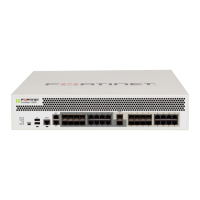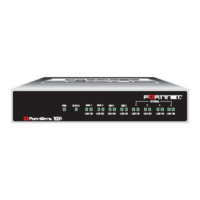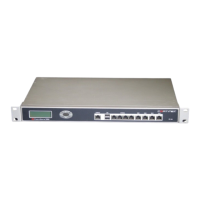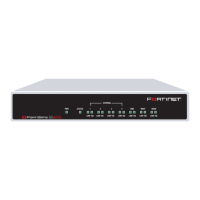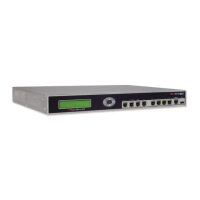FortiGate-60 series and FortiGate-100A FortiOS 3.0 MR4 Install Guide
30 01-30004-0266-20070831
Planning the FortiGate configuration Configuring the FortiGate unit
Add firewall policies to control whether communications through the FortiGate unit
operate in NAT or Route mode. Firewall policies control the flow of traffic based on
the source address, destination address, and service of each packet. In NAT
mode, the FortiGate unit performs network address translation before it sends the
packet to the destination network. In Route mode, there is no address translation.
You typically use NAT/Route mode when the FortiGate unit is operating as a
gateway between private and public networks. In this configuration, you would
create NAT mode firewall policies to control traffic flowing between the internal,
private network and the external, public network (usually the Internet).
Figure 4: FortiGate-60 NAT/Route mode network configuration
NAT/Route mode with multiple external network connections
In NAT/Route mode, you can configure the FortiGate unit with multiple redundant
connections to the external network (usually the Internet).
For example, you could create the following configuration:
• WAN1 is the default interface to the external network (usually the Internet)
• Modem is the redundant interface to the external network for the FortiGate-60
series
• DMZ is the redundant interface to the external network on the FortiGate-100A
• Internal is the interface to the internal network
You must configure routing to support redundant Internet connections. Routing
can automatically redirect connections from an interface if its connection to the
external network fails.
The security policy configuration is similar to a NAT/Route mode configuration
with a single Internet connection. Create NAT mode firewall policies to control
traffic flowing between the internal, private network and the external, public
network.
Note: If you have multiple internal networks, such as a DMZ network in addition to the
internal, private network, you could create route mode firewall policies for traffic flowing
between them.
Internet
Router
Internal
network
DMZ
10.10.10.1
10.10.10.2
Internal
Network
192.168.1.3
Internal
192.168.1.99
Routing policies controlling
traffic between internal
networks.
WAN1
204.23.1.5
NAT mode policies controlling
traffic between internal
and external networks.
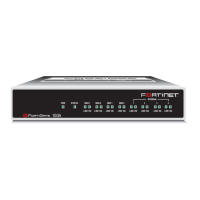
